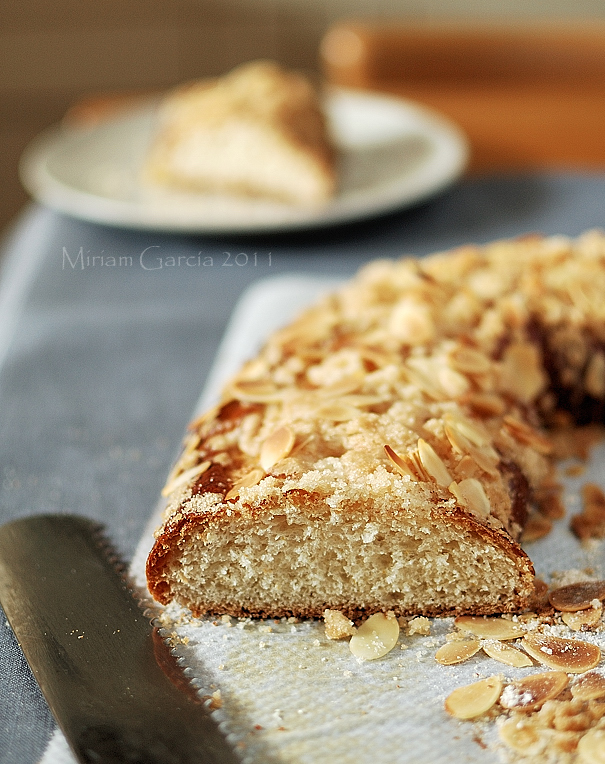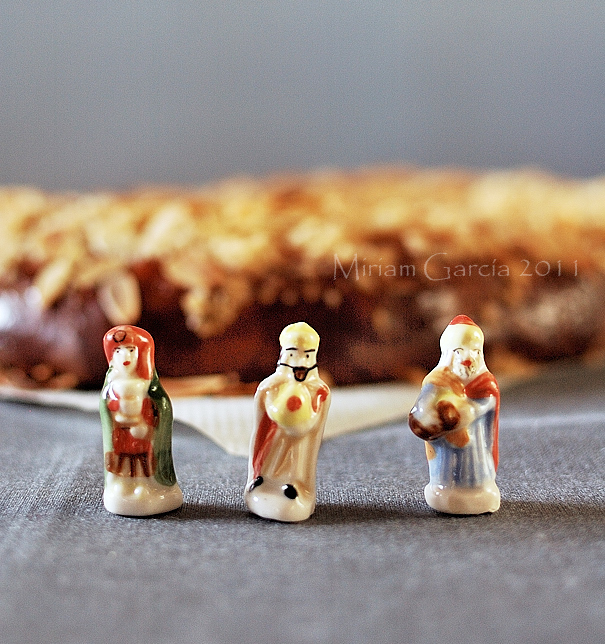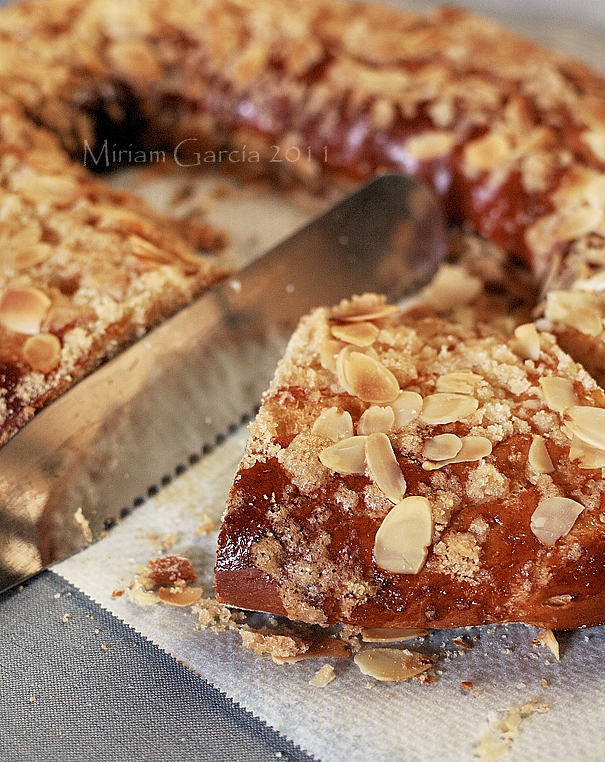
Roscón de Reyes is a strong tradition in Spain (check the pronunciation of roscón here). It is eaten on the Día de Reyes or Three Kings day and also on the previous eve, when traditionally presents are given, in remembrance of the presents the Kings brought to baby Jesus. Roscón de Reyes is a brioche-y bun in the shape of a crown, traditionally studded with colorful candied fruit and scented with orange and lemon zest and orange blossom water (these flavorings are essential to a Spanish roscón, otherwise you just cannot call it such). Today roscón has become so widely popular that the cakes are baked all over Spain in huge amounts since the beginning of January or even earlier, which inevitably means that in many supermarkets and pastry shops you find stuff of very low quality. Which inevitably leads, if you are fond of baking at all like I am, to prepare it yourself. And it is not difficult, only a bit time consuming as any yeast-leavened sweet bread is. But well worth the effort.

The Christmas season has not always been so Christian as it is now. The origin of roscón has nothing to do with the arrival of the Magi to Bethlehem to worship the child, but appears to be related to the Roman Saturnalia. These were celebrations dedicated to the god Saturn in which the Roman people celebrated the longer days that started soon after the winter solstice. For these celebrations round cakes with figs, dates and honey were prepared, which were divided equally among the commoners and the slaves. Already in the 3rd century, it was usual to hide a dry bean inside the cake, and the fortunate finder was named king of kings for a short period of time agreed beforehand. This type of game was popular in the Iberian peninsula since the Roman era, he who found the bean had to pay the treat for the others... Nowadays a small figurine is hidden in the cake and the person who happens to find it is set to pay for the roscón. That is not possible if you make it at home, of course.
This recipe is uncomplicated and it works, although you need to have a basic knowledge of bread kneading and sweet doughs in general. It is adapted from my Thermomix cookbook. It yields 2 medium roscones or a large one.
Roscón de Reyes
For the flavored sugar
- 120g icing sugar
- Zest of 1 lemon
- Zest of 1 orange (feel free to use more)
For the preferment
- 40g whole milk
- 30g water (you can use also 70g skimmed milk instead of the milk and water)
- 10g fresh baker's yeast
- 130g strong flour
For the main dough
- 30g whole milk
- 30g water
- 70g butter, softened
- 2 large eggs or 3 small ones
- 15g fresh baker's yeast
- 30g orange blossom water (it may sound like a lot, but roscón is not roscón without this)
- 1 tbsp rhum (optional)
- 450g strong flour
- 1 pinch salt
- The flavored sugar
- The preferment
For garnish
- Beaten egg glazing
- Candied fruit
- Sliced almonds
- Sugar
- Butter

- Fine, let's make the preferment first. Sift the flour, crumble the fresh yeast on top, add the liquid and knead until just mixed.
- Then fill with tepid water a bowl where the dough ball can fit and put the dough in it. When the dough is fermented enough, the ball will float. It can take from 15 minutes to half an hour, it depends on the temperature on your kitchen.
- In the meantime, zest the lemon and the orange and mix the zest with the icing sugar; cover and set aside to let the aromas permeate the sugar.
- Now for the main dough: sift the flour again, add the crumbled yeast, eggs, flavored sugar, orange blossom water, milk, water, preferment and salt (everything but the butter). Knead by hand or in a stand mixer with the hook attachment until you have an elastic dough. Make a ball and leave to rest for 10 minutes, covered. I prefer to let the dough stand for a while without the butter, as fat interferes in the gluten formation. Somewhere in the future I will divide the dough in two and try to add everything altogether to the first dough and delay adding the butter to the second dough, then check if the final cakes show some difference.
- After the rest, flatten the dough on the counter and smear the soft butter (I prefer to do this by hand), knead thoroughly to mix well. When the dough is smooth enough, make a ball, put into an oiled bowl, brush the surface with oil too and let double in bulk, well covered. Mine takes between 3 and 5 hours, but it depends on temperature again and on how active your fresh yeast is.
- Once the dough is doubled, tip it on the floured counter and flatten with your hands to degas completely. Divide the dough in two, then make a ball with each dough portion. Set one aside.
- Leave the first ball to rest for a couple of minutes. Prepare two parchment papers the size of your oven sheets, flour them lightly.
- Lay one of the dough balls on one of the papers, then punch a hole in the middle with your floured fingers and start opening the hole. Stretch the ring of dough little by little. If it tends to shrink, let it rest for another couple of minutes before resuming your stretching. In the end the ring should be about 6-7cm thick and have an oval shape about 30x40cm.
- Brush the roscón thoroughly with beaten egg, cover with plastic (though the plastic shouldn't touch the roscón as it would stick to it) and let nearly double again, it will take at least one hour. Repeat the whole process for the second dough ball.
- Half way the rising, preheat your oven to at least 180-190ºC if your oven is of the air convection type like mine, somewhat closer to 200ºC if radiation type, but not higher than that (again, you know this depends largely on every oven).
- When the roscones have almost doubled, brush them with egg again, very carefully as the dough is a delicate thing at this point. Then you have two options: the traditional one is to stud the whole thing with colorful candied fruit as though the fruits were the jewels in the crown. The second one and my favourite (at home we are not exactly fond of radioactive-colored candied fruit in cakes) is to mix a handful of sugar in melted butter or in some water (just enough to get a crumbly mixture) and sprinkle on the roscón. Then sprinkle some sliced almonds too on top... delicious.
- Put the roscones into the oven for 10 minutes, then lower the heat by 10ºC and leave some further 10-15 minutes (cover with aluminum foil if you find they brown too much). After the baking time, take them out and let cool on the sheets.
This time my roscones were a bit overfermented, that is why they are a bit on the flat side. A good roscón should have a rounder section. Nowadays a lot of people like their roscón stuffed with whipped cream, ganache or many other fancy fillings, you just open the roscón like a giant bagel and pipe the filling, then replace the top half. I do not like this at all, but feel free to do it. I won't interfere, but I will lose all respect for you... However, of course you must have your roscón with hot chocolate... I admit no objections about it. I would be soooo disapointed if you would not...

And by the way, this is my first submission of the year for YeastSpotting, Happy New Year, Susan!






















13 comentarios:
I always asscociate Kings Cake with New Orleans and not it's true meaning. It does look good Miriam.
First and foremost... A Happy New Year to you, Miriam! Thank you for including such rich history behind your posts. I learn many things from your blog. This is a beautiful cake/bread with what looks like a lovely texture.
This year I definitely want to challenge myself with making yeast breads..it's an art and you've inspired me so many times.
It goes without saying, but I must nonetheless - stunning photography!
a very good tradition :)
it seems tastefull
will take note of the recipe...
Looks delicious with the almonds on top, and I love your figurines!
Bueno !!! Este si que està cerca de mi historia, aunque en Buenos Aires, se lo decora también con crema pastelera! y lo llamamos Rosca...pero el resto es igual !!
gracias por el recuerdo !!
Wonderful! This is simply beautful cake. Orange blossom water is the perfect additions for a wonderful flavour.
This is I believe your second post in a row that reminds me of New Orleans! There, the person who finds the baby in the cake has to host next year's party. Ok, I can't say roscón ... I cannot physically roll my "r." Does that mean I can really truly not speak Spanish properly, ever? Makes me sad. Beautiful cake! All the good stuff originates with the pagans, eh? ; )
i like sweet breads. thanks for the great post!
Val: I sooo much would like to try the New Orleans stuff...
Cristina: you have to! Breadmaking is really not so difficult, just requires a little trial and error...
Gio: ;)
Lisa: the figurines are sooo lovely ;)
Cristina: sí!!
MC: it's a peculiar flavor, not everybody likes it though.
Trix: well, you know the French have their "galette des rrrrrrois" (try to roll this "r"... ), which is a similar thing in fact. And probably that's why there's some similar cake in New Orleans... I feel more like visiting it everyday.
Dina: thanks!
That looks beautiful. I love breads like that and the almonds on top make it the perfect bread!
Miriam, Que belleza!!! Te ha quedado tan delicado y tentador. Me trae muy lindos recuerdos este pan.
Espero que hayas pasado unas hermosas fiestas. Y todo lo mejor para ti este 20111
Besotes,
Aldy.
Simone: thanks!
ADG: lo mejor para ti, Aldy!
Just came back from Malaga where I believe this cake was being sold at the pastry shop (just uploaded it to facebook), it looks a little bit different though. Great pictures and perfect with hot chocolate!
Post a Comment